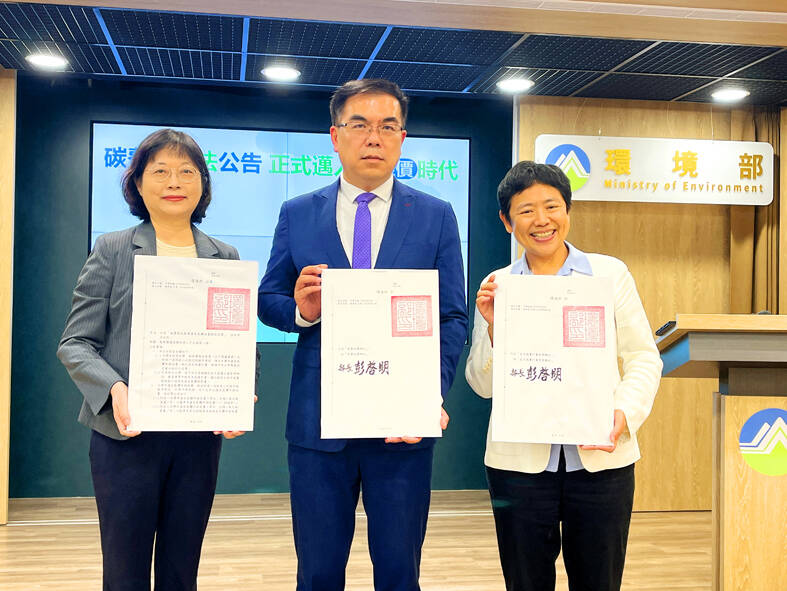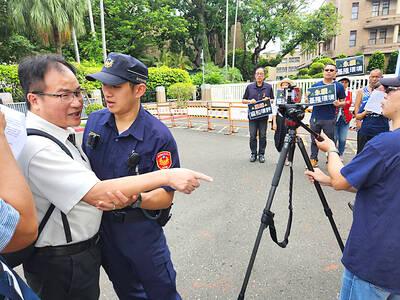The Ministry of Environment yesterday unveiled regulations governing carbon fee collection, autonomous emission reduction and greenhouse gas reduction targets for carbon fee payers in a bid to prepare industries for carbon pricing.
Fee collection would not begin until 2026, with next year to be a preparation window for fee-paying enterprises, the ministry said.
However, fee-liable businesses would still be required to report their 2024 emissions during this grace period.

Photo: Chen Chia-yi, Taipei Times
Taiwan’s carbon fee scheme would apply to 281 electric utility companies, natural gas suppliers and manufacturers who accounted for 54 percent of the nation’s total carbon emissions per year, officials said.
The criteria for paying carbon fees is ownership of an industrial facility that emits at least 25,000 tonnes of carbon a year, of which there are 500, they said.
The data are based on a 2002 industrial survey, the officials said.
The fifth carbon fee assessment and evaluation conference is to convene on Sept. 9 to set carbon rates and formalize a timetable by the end of the year, Minister of Environment Peng Chi-ming (彭啟明) said.
Companies are expected to submit emission reports starting in May next year and payments would commence the following year, he said.
The tentative schedule is designed to give enterprises sufficient time to set corporate emission reduction targets for 2030 and submit action plans to achieve that goal to the government, Peng said.
Climate Change Administration Director-General Tsai Ling-yi (蔡玲儀) said that 10 government-business conferences would be held to facilitate the adoption of reduction strategies and technologies.
Carbon fee payers may buy domestic carbon credits from voluntary reduction projects at a discount of one carbon credit for 1.2 tonnes of emissions capped at 10 percent of chargeable emissions, ministry officials said.
Enterprises not engaged in high-emission activities would be allowed to buy domestic or approved international carbon credits at a discount of one carbon credit for 1.3 tonnes of emission capped at 5 percent of chargeable emissions, they said.
Meanwhile, Taiwan Carbon Solution Exchange (TCX) chief executive officer Joshua Tien (田建中) said Taiwan’s domestic carbon credit exchange platform would launch on Oct. 2.
Tien told a forum on Wednesday that the TCX had been engaged in discussions with the ministry over the details of domestic carbon credit trading since related regulations came into effect on Aug. 15.
As a carbon fee scheme has yet to begin, the trading platform would mainly be for those planning to build new factories, he said.
Regulations announced in October last year require those setting up new factories of a particular scale and developers of high-rise construction projects to partly offset newly generated emissions by buying carbon credits from voluntary projects or implementing other offsetting measures.
Carbon credits generated from offsetting projects would be able to be sold on the platform first to buyers seeking to meet environment assessment requirements, such as construction and development projects, Tien said.
He said domestic carbon credits could be used to partly offset soon-to-be-collected carbon fees, adding that purchasing carbon credits would be better for corporate image than simply paying the fees.
Chargeable emissions would be calculated from the date the carbon fee rate is officially announced.

Environmental groups yesterday filed an appeal with the Executive Yuan, seeking to revoke the environmental impact assessment (EIA) conditionally approved in February for the Hsieh-ho Power Plant’s planned fourth liquefied natural gas (LNG) receiving station off the coast of Keelung. The appeal was filed jointly by the Protect Waimushan Seashore Action Group, the Wild at Heart Legal Defense Association and the Keelung City Taiwan Head Cultural Association, which together held a news conference outside the Executive Yuan in Taipei. Explaining the reasons for the appeal, Wang Hsing-chih (王醒之) of the Protect Waimushan Seashore Action Group said that the EIA failed to address

Taipei on Thursday held urban resilience air raid drills, with residents in one of the exercises’ three “key verification zones” reporting little to no difference compared with previous years, despite government pledges of stricter enforcement. Formerly known as the Wanan exercise, the air raid drills, which concluded yesterday, are now part of the “Urban Resilience Exercise,” which also incorporates the Minan disaster prevention and rescue exercise. In Taipei, the designated key verification zones — where the government said more stringent measures would be enforced — were Songshan (松山), Zhongshan (中山) and Zhongzheng (中正) districts. Air raid sirens sounded at 1:30pm, signaling the

The number of people who reported a same-sex spouse on their income tax increased 1.5-fold from 2020 to 2023, while the overall proportion of taxpayers reporting a spouse decreased by 4.4 percent from 2014 to 2023, Ministry of Finance data showed yesterday. The number of people reporting a spouse on their income tax trended upward from 2014 to 2019, the Department of Statistics said. However, the number decreased in 2020 and 2021, likely due to a drop in marriages during the COVID-19 pandemic and the income of some households falling below the taxable threshold, it said. The number of spousal tax filings rebounded

A saleswoman, surnamed Chen (陳), earlier this month was handed an 18-month prison term for embezzling more than 2,000 pairs of shoes while working at a department store in Tainan. The Tainan District Court convicted Chen of embezzlement in a ruling on July 7, sentencing her to prison for illegally profiting NT$7.32 million (US$248,929) at the expense of her employer. Chen was also given the opportunity to reach a financial settlement, but she declined. Chen was responsible for the sales counter of Nike shoes at Tainan’s Shinkong Mitsukoshi Zhongshan branch, where she had been employed since October 2019. She had previously worked